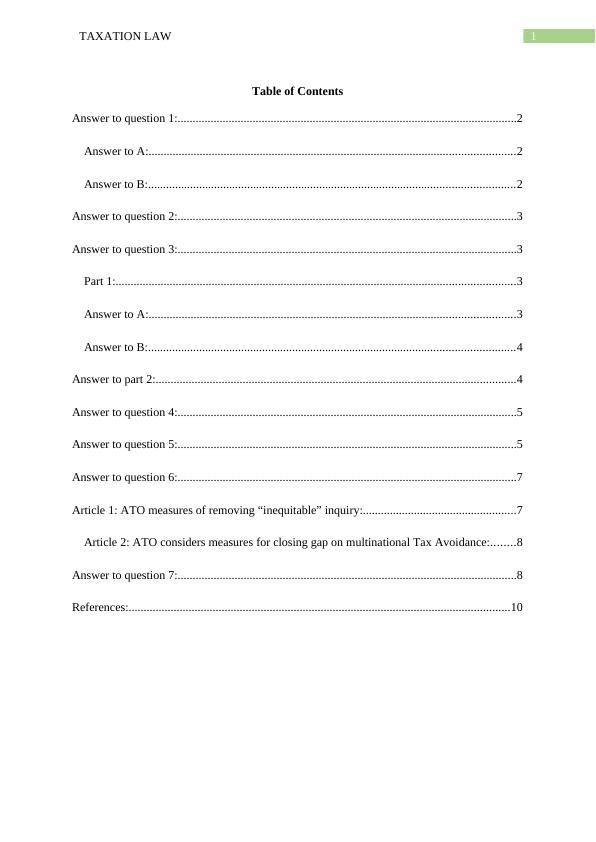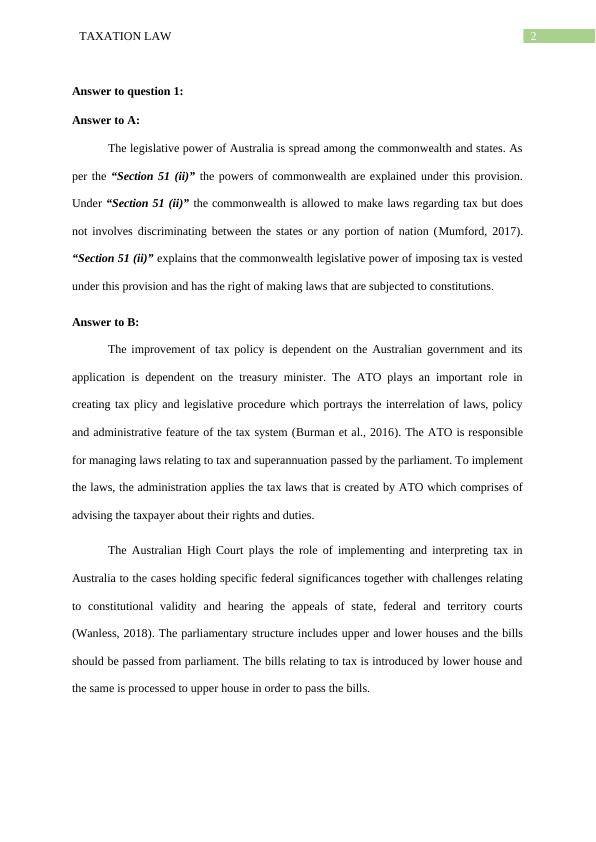Taxation Law
Added on 2023-02-01
12 Pages2825 Words55 Views
Running head: TAXATION LAW
Taxation Law
Name of the Student
Name of the University
Authors Note
Course ID
Taxation Law
Name of the Student
Name of the University
Authors Note
Course ID

1TAXATION LAW
Table of Contents
Answer to question 1:.................................................................................................................2
Answer to A:..........................................................................................................................2
Answer to B:..........................................................................................................................2
Answer to question 2:.................................................................................................................3
Answer to question 3:.................................................................................................................3
Part 1:.....................................................................................................................................3
Answer to A:..........................................................................................................................3
Answer to B:..........................................................................................................................4
Answer to part 2:........................................................................................................................4
Answer to question 4:.................................................................................................................5
Answer to question 5:.................................................................................................................5
Answer to question 6:.................................................................................................................7
Article 1: ATO measures of removing “inequitable” inquiry:...................................................7
Article 2: ATO considers measures for closing gap on multinational Tax Avoidance:........8
Answer to question 7:.................................................................................................................8
References:...............................................................................................................................10
Table of Contents
Answer to question 1:.................................................................................................................2
Answer to A:..........................................................................................................................2
Answer to B:..........................................................................................................................2
Answer to question 2:.................................................................................................................3
Answer to question 3:.................................................................................................................3
Part 1:.....................................................................................................................................3
Answer to A:..........................................................................................................................3
Answer to B:..........................................................................................................................4
Answer to part 2:........................................................................................................................4
Answer to question 4:.................................................................................................................5
Answer to question 5:.................................................................................................................5
Answer to question 6:.................................................................................................................7
Article 1: ATO measures of removing “inequitable” inquiry:...................................................7
Article 2: ATO considers measures for closing gap on multinational Tax Avoidance:........8
Answer to question 7:.................................................................................................................8
References:...............................................................................................................................10

2TAXATION LAW
Answer to question 1:
Answer to A:
The legislative power of Australia is spread among the commonwealth and states. As
per the “Section 51 (ii)” the powers of commonwealth are explained under this provision.
Under “Section 51 (ii)” the commonwealth is allowed to make laws regarding tax but does
not involves discriminating between the states or any portion of nation (Mumford, 2017).
“Section 51 (ii)” explains that the commonwealth legislative power of imposing tax is vested
under this provision and has the right of making laws that are subjected to constitutions.
Answer to B:
The improvement of tax policy is dependent on the Australian government and its
application is dependent on the treasury minister. The ATO plays an important role in
creating tax plicy and legislative procedure which portrays the interrelation of laws, policy
and administrative feature of the tax system (Burman et al., 2016). The ATO is responsible
for managing laws relating to tax and superannuation passed by the parliament. To implement
the laws, the administration applies the tax laws that is created by ATO which comprises of
advising the taxpayer about their rights and duties.
The Australian High Court plays the role of implementing and interpreting tax in
Australia to the cases holding specific federal significances together with challenges relating
to constitutional validity and hearing the appeals of state, federal and territory courts
(Wanless, 2018). The parliamentary structure includes upper and lower houses and the bills
should be passed from parliament. The bills relating to tax is introduced by lower house and
the same is processed to upper house in order to pass the bills.
Answer to question 1:
Answer to A:
The legislative power of Australia is spread among the commonwealth and states. As
per the “Section 51 (ii)” the powers of commonwealth are explained under this provision.
Under “Section 51 (ii)” the commonwealth is allowed to make laws regarding tax but does
not involves discriminating between the states or any portion of nation (Mumford, 2017).
“Section 51 (ii)” explains that the commonwealth legislative power of imposing tax is vested
under this provision and has the right of making laws that are subjected to constitutions.
Answer to B:
The improvement of tax policy is dependent on the Australian government and its
application is dependent on the treasury minister. The ATO plays an important role in
creating tax plicy and legislative procedure which portrays the interrelation of laws, policy
and administrative feature of the tax system (Burman et al., 2016). The ATO is responsible
for managing laws relating to tax and superannuation passed by the parliament. To implement
the laws, the administration applies the tax laws that is created by ATO which comprises of
advising the taxpayer about their rights and duties.
The Australian High Court plays the role of implementing and interpreting tax in
Australia to the cases holding specific federal significances together with challenges relating
to constitutional validity and hearing the appeals of state, federal and territory courts
(Wanless, 2018). The parliamentary structure includes upper and lower houses and the bills
should be passed from parliament. The bills relating to tax is introduced by lower house and
the same is processed to upper house in order to pass the bills.

3TAXATION LAW
Answer to question 2:
The Double Taxation Agreement between US and Australia states that the revenue
derived in one contracting country will attract tax liability in that country except when the
company is performing the business in another contracting country with the help of
permanent establishment (Pavkovic & Radan, 2016). The liability to tax the business profits
is only made in another country till the extent which is attributable to permanent
establishment. According to “section 6-5, ITAA 1997”, resident of Australia is to pay tax on
income derived from every sources but the non-resident under “section 6-10, ITAA 1997”
are only required to pay tax on Australian sourced income.
A company is in Australian resident company given company’s central management
and control is remaining vested in Australia. Usually business income is levied tax where the
transaction happens. In “C of T (NSW) v Hillsdon Watts Ltd (1937)” it was held that the
business income arises where the transaction happens (Rose & Karran, 2018). It involves
those place where the contract is performed and it is the only relevant factor in determining
source. As per DTA profits obtained from Australian sources made by the US manufacturer
is held assessable in Australia for US firm because the profits were sourced in Australia.
Answer to question 3:
Part 1:
Answer to A:
Capital gains is applicable on assets which is purchased on or after the introduction of
CGT system on 20th September 1985. The pre-CGT and post-CGT assets is generally applied
on assets that is purchased or evens which happens before or following the date (Stiglitz,
2015). If Indiana decides to sub-divide the property in 80 blocks and selling the same, the
Answer to question 2:
The Double Taxation Agreement between US and Australia states that the revenue
derived in one contracting country will attract tax liability in that country except when the
company is performing the business in another contracting country with the help of
permanent establishment (Pavkovic & Radan, 2016). The liability to tax the business profits
is only made in another country till the extent which is attributable to permanent
establishment. According to “section 6-5, ITAA 1997”, resident of Australia is to pay tax on
income derived from every sources but the non-resident under “section 6-10, ITAA 1997”
are only required to pay tax on Australian sourced income.
A company is in Australian resident company given company’s central management
and control is remaining vested in Australia. Usually business income is levied tax where the
transaction happens. In “C of T (NSW) v Hillsdon Watts Ltd (1937)” it was held that the
business income arises where the transaction happens (Rose & Karran, 2018). It involves
those place where the contract is performed and it is the only relevant factor in determining
source. As per DTA profits obtained from Australian sources made by the US manufacturer
is held assessable in Australia for US firm because the profits were sourced in Australia.
Answer to question 3:
Part 1:
Answer to A:
Capital gains is applicable on assets which is purchased on or after the introduction of
CGT system on 20th September 1985. The pre-CGT and post-CGT assets is generally applied
on assets that is purchased or evens which happens before or following the date (Stiglitz,
2015). If Indiana decides to sub-divide the property in 80 blocks and selling the same, the

End of preview
Want to access all the pages? Upload your documents or become a member.
Related Documents
Taxation Lawlg...
|12
|2952
|67
Taxation Lawlg...
|12
|2912
|77
Taxation Lawlg...
|12
|3033
|55
Taxation Lawlg...
|12
|2985
|62
Taxation Lawlg...
|11
|2538
|83
Taxation Lawlg...
|12
|2811
|73
